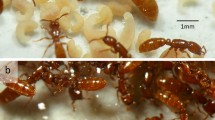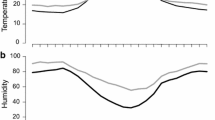Summary.
We present field and laboratory data on the Neotropical formicine ant Gigantiops destructor (Fabricius), the sole species of its genus and tribe. Monogynous and polydomous colonies of G. destructor from French Guiana are distributed along the rainforest edges or along streams with a nest density of about 300 nests/ha. The species presents rudimentary nesting habits, as most nests are found in pre-existing cavities in the ground, but some can be found in the hollowed internodes of Cecropia trees fallen onto the ground. A worker, sometimes hidden in a separate "sentry box", might guard the nest entrance. Colony size can reach several hundreds of workers. The foraging activity of the workers is strictly diurnal with a peak between 9:30 and 11:30. This largest-eyed of all known ant species has remarkable leaping abilities even more impressive than in other jumping ants. Workers are generalist solitary foragers. They collect extra-floral nectar from different plant species and prey on various small live arthropods that they detect visually before tracking and jumping on them. The same individual can forage both on prey and sugary sources during a single foraging trip. Foragers can eat their prey on site and never recruit nestmates in the field or even after a starvation period in the laboratory. They feed larvae with chewed prey. The complete lack of cooperation between foraging workers that can also fight for a prey with a nestmate, combined with the absence of any recruitment for large food sources, constitute a cluster of individualist traits rather unusual for an eusocial insect.
Similar content being viewed by others
Author information
Authors and Affiliations
Additional information
Received 21 November 2000; revised 19 March and 15 May 2001; accepted 21 May 2001.
Rights and permissions
About this article
Cite this article
Beugnon, G., Chagné, P. & Dejean, A. Colony structure and foraging behavior in the tropical formicine ant, Gigantiops destructor. Insectes soc. 48, 347–351 (2001). https://doi.org/10.1007/PL00001788
Issue Date:
DOI: https://doi.org/10.1007/PL00001788




